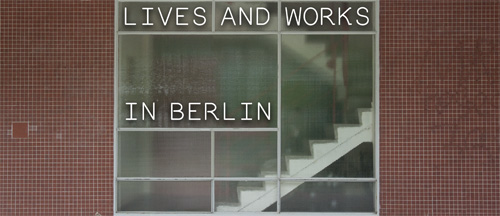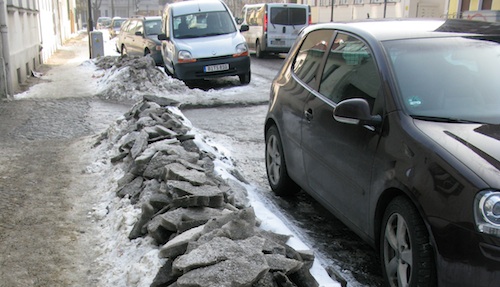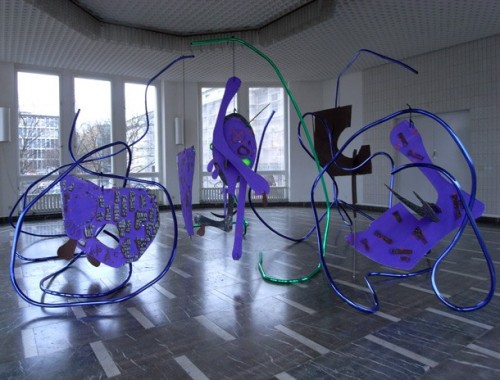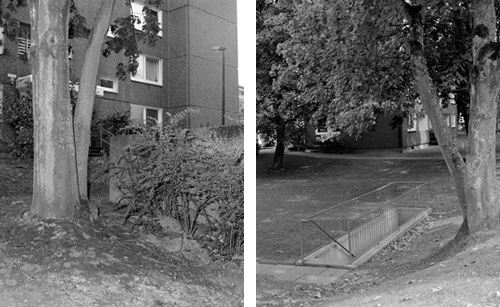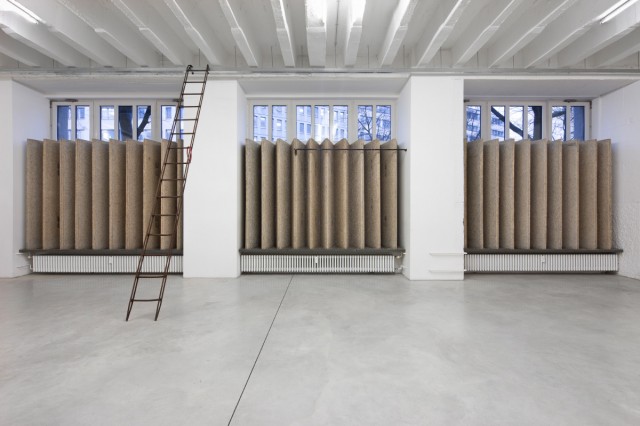January isn’t often a big month for art, and the same usually goes for Berlin, but this year, galleries seem to be pushing things a bit further to present exciting shows, even if a majority of them seem to have opened in November. In addition to “regular programming,” January brought the third instance of the Berlin-Paris gallery swap to town, as well as the lead into the Transmediale festival, which straddles the lines between music, performance, and art (now currently underway). But since this is actually happening in February (thankfully, it’s not as sloppy, so far, as last February), here’s a look at a few shows that eased us through the month of Janus.
At the Schinkel Pavillion, an installation by Aaron Curry presents us with a tangle of purple and green-chromed tubes with a complicated accumulation of paper-covered cardboard chunks hanging from various points on the colorful tubing. Actually 6 separate works, they first appear somewhat haphazard and unconsidered (a cynic might view this as someone carelessly blowing their production budget on bent chromed tubes); upon further contemplation, one realizes that not only are these purple and brown colored cardboard pieces more well-crafted and considered than expected, they have tasty painted elements as well, nestled into the (silkscreened?) color swaths. Purple shapes have brown smears, brown shapes have purple smears. Painted within these smears, there are simply rendered “water droplets: condensed on the contrasting colors, as if they were made of a material cooler than the air around them, or possible to some oily substance, retaining and repelling the dew of summer mornings. The cardboard shapes recall those of Miró or Tanguy, as do many of Curry’s other sculptural works, the markings upon them suggesting edits or bandages, as do the strips of cloth tape in matching colors holding further cut-up pieces of purple or brown to the main body of these often squiggly, choppy shapes.
At Barbara Wein Wilma Lukatsch, Elisabeth Neudörfl exhibits Habitat (her contribution to Thomas Weski’s Ruhr Views project), a series of large black & white photographic “portraits” of various banal outdoor spaces. Though this could seem rather boring at first thought, the 72-photo series encourages us to question the notion of “the right view” of something, oftentimes presenting three views of a specific area of something as mundane as the courtyard of an apartment building, or the tree out front. Not only do they cause use to think about everyday scenes (devoid of people), the photos are taken using the flash, which gives objects harsh drop-shadows and, as the press release says, makes “them look like photographs of a crime scene” of which we do not know the nature, opening us to the uncertainty of what might have or what could happen in this anonymous location.
At Galerija Gregor Podnar, Simone Menegoi has curated Cimento dell’armonia e dell’invenzione: or, The Drawing Machines, a group show of artists who use systems of their own design to create drawings, often involving chance. Nick Laessing uses pendulums to create his series Spatial Harmonics (2010); concentric rings with curled and twisted cores, resemble darkened orifices or belly buttons. Diogo Pimentão utilizes hundreds of broken bits of pencil graphite shaken about in a tupperware container taped to the paper to create the soft forms and gradients in his drawings Centrípedo and Fogo (both 2009). Tim Knowles contributes a selection from his clever Tree Drawing (2005) series, which consist of a photograph of a tree with a pen taped to one of its branches, “drawing” (the wind is a factor here, of course) on a piece of paper set up on an easel, and the resulting drawing framed next to it. The exhibition, which also features works by William Anastasi, Sol Lewitt, and Jean Tinguely, among others, is a enjoyable sampling of current and older system- and/or chance-based drawing practices.
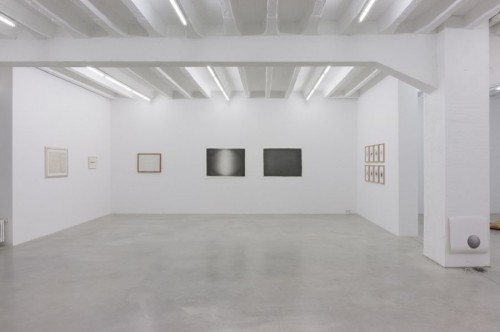
Exhibition view of "Cimento dell’armonia e dell’invenzione: or, The Drawing Machines" at Galerija Gregor Podnar. Photo: Marcus Schneider
Franka Hörnschemeyer‘s In The Presence of Noise at Galerie Nordenhake, the artist employs various common building materials, as she is known to do, to create a series of site-specific installations and multiples playing with the concept of space and material. In Volume of Sphere I, II & 3 (all 2010), thick Heraklith slabs stand at attention in the windows, blocking out all but the tiniest slice of light from the outside world, but pushing their gritty, “sour kraut” texture into your face in accordion-like folds. In Simple Entity in a Complex Space (2010), aluminum panels get a similar accordion-like treatment, recalling Hörnschemeyer’s GKB (2005), where sheetrock panels are also sliced and hung on the wall, the flapping panels held together simply by the paper that backs each sheet, in a delicate and overbearing balancing act. The two aluminum funnels that penetrate the wall in Discrete Case (2010) allude to hearing and vision, as well as voyeurism and exploration. If In The Presence of Noise felt a bit overcrowded and overly diverse in materials compared to Hörnschemeyer’s other, more limited-material installations, such as sheetrock or scaffolding, it could be contemplated that this exhibition is more of a review of projects that she is exploring, and, most likely, planning to execute on a larger scale, such as BFD – bündig fluchtend dicht, (2001).

